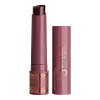What's inside
What's inside
 Key Ingredients
Key Ingredients

 Benefits
Benefits

 Concerns
Concerns

 Ingredients Side-by-side
Ingredients Side-by-side

Polyisobutene
Octyldodecanol
EmollientEthylhexyl Palmitate
EmollientCaprylic/Capric Triglyceride
MaskingHydrogenated Styrene/Isoprene Copolymer
Bis-Diglyceryl Polyacyladipate-2
EmollientSynthetic Wax
AbrasiveSynthetic Fluorphlogopite
Stearalkonium Hectorite
Gel FormingPhenoxyethanol
PreservativeSilica
AbrasivePropylene Carbonate
SolventParfum
MaskingSqualane
EmollientTocopheryl Acetate
AntioxidantPentaerythrityl Tetra-Di-T-Butyl Hydroxyhydrocinnamate
AntioxidantTin Oxide
AbrasiveAluminum Hydroxide
EmollientBenzyl Alcohol
PerfumingHydroxycitronellal
PerfumingBenzyl Salicylate
PerfumingHexyl Cinnamal
PerfumingCI 77891
Cosmetic ColorantCI 77491
Cosmetic ColorantCI 77492
Cosmetic ColorantCI 77499
Cosmetic ColorantCI 15850
Cosmetic ColorantCI 19140
Cosmetic ColorantPolyisobutene, Octyldodecanol, Ethylhexyl Palmitate, Caprylic/Capric Triglyceride, Hydrogenated Styrene/Isoprene Copolymer, Bis-Diglyceryl Polyacyladipate-2, Synthetic Wax, Synthetic Fluorphlogopite, Stearalkonium Hectorite, Phenoxyethanol, Silica, Propylene Carbonate, Parfum, Squalane, Tocopheryl Acetate, Pentaerythrityl Tetra-Di-T-Butyl Hydroxyhydrocinnamate, Tin Oxide, Aluminum Hydroxide, Benzyl Alcohol, Hydroxycitronellal, Benzyl Salicylate, Hexyl Cinnamal, CI 77891, CI 77491, CI 77492, CI 77499, CI 15850, CI 19140
Diisostearyl Malate
EmollientPolybutene
Polyglyceryl-2 Triisostearate
EmulsifyingBis-Diglyceryl Polyacyladipate-2
EmollientCaprylic/Capric Triglyceride
MaskingMenthoxypropanediol
MaskingSynthetic Wax
AbrasiveMicrocrystalline Wax
Emulsion StabilisingStearalkonium Hectorite
Gel FormingParaffin
PerfumingTocopheryl Acetate
AntioxidantPropylene Carbonate
SolventEthylene/Propylene Copolymer
AbrasiveCaprylyl Glycol
EmollientPhenoxyethanol
PreservativeButyrospermum Parkii Butter
Skin ConditioningAroma
Hexylene Glycol
EmulsifyingPentaerythrityl Tetra-Di-T-Butyl Hydroxyhydrocinnamate
AntioxidantVanillyl Butyl Ether
MaskingCI 77499
Cosmetic ColorantCI 15850
Cosmetic ColorantCI 77491
Cosmetic ColorantCI 45410
Cosmetic ColorantDiisostearyl Malate, Polybutene, Polyglyceryl-2 Triisostearate, Bis-Diglyceryl Polyacyladipate-2, Caprylic/Capric Triglyceride, Menthoxypropanediol, Synthetic Wax, Microcrystalline Wax, Stearalkonium Hectorite, Paraffin, Tocopheryl Acetate, Propylene Carbonate, Ethylene/Propylene Copolymer, Caprylyl Glycol, Phenoxyethanol, Butyrospermum Parkii Butter, Aroma, Hexylene Glycol, Pentaerythrityl Tetra-Di-T-Butyl Hydroxyhydrocinnamate, Vanillyl Butyl Ether, CI 77499, CI 15850, CI 77491, CI 45410
Ingredients Explained
These ingredients are found in both products.
Ingredients higher up in an ingredient list are typically present in a larger amount.
This ingredient is lipid-based synthetic skin-conditioning agent derived from adipic acid and a mixture of fatty acids. It is often called a lanolin substitute.
As an emollient, it helps soften and hydrate the skin. Emollients create a barrier on the skin to trap moisture in.
Due to its fatty acid base, it may not be Malassezia folliculitis safe.
Learn more about Bis-Diglyceryl Polyacyladipate-2This ingredient is an emollient, solvent, and texture enhancer. It is considered a skin-softener by helping the skin prevent moisture loss.
It helps thicken a product's formula and makes it easier to spread by dissolving clumping compounds.
Caprylic Triglyceride is made by combining glycerin with coconut oil, forming a clear liquid.
While there is an assumption Caprylic Triglyceride can clog pores due to it being derived from coconut oil, there is no research supporting this.
Learn more about Caprylic/Capric TriglycerideCi 15850 is the pigment color red. It is an azo dye and created synthetically.
Azo dyes need to be thoroughly purified before use. This allows them to be more stable and longer-lasting.
This ingredient is common in foundations, lipsticks, and blushes. This color is described as brown/orangey red.
It has many secondary names such as Red 6 and Red 7. According to a manufacturer, Red 6 usually contains aluminum.
Learn more about CI 15850Ci 77491 is also hydrated iron III oxide. It's sole purpose is to give a red/pink hue to products.
Iron III oxides are classified as inorganic chemicals for coloring.
Synthetically created Ci 77491 is considered safer than those naturally found. This is because the synthetically created version may contain less impurities. Iron oxides are generally non-toxic and non-allergenic.
Learn more about CI 77491Ci 77499 is also hydrated iron III oxide. It is created from mixing red and black iron oxides. This helps give shades of darkness to a product.
Iron III oxides are classified as inorganic chemicals for coloring.
Pentaerythrityl Tetra-Di-T-Butyl Hydroxyhydrocinnamate (long name, huh?) is a synthetic antioxidant.
It is used to help stabilize other antioxidants or prevent the color from changing in a product.
As an antioxidant, it helps fight free-radical molecules. Free-radical molecules are capable of damaging our cells and other genetic material. Thus, antioxidants may reduce the signs of aging.
This ingredient is oil-soluble.
Learn more about Pentaerythrityl Tetra-Di-T-Butyl HydroxyhydrocinnamatePhenoxyethanol is a preservative that has germicide, antimicrobial, and aromatic properties. Studies show that phenoxyethanol can prevent microbial growth. By itself, it has a scent that is similar to that of a rose.
It's often used in formulations along with Caprylyl Glycol to preserve the shelf life of products.
This ingredient is a solvent. It helps dissolve active ingredients and alter the texture of products.
Propylene Carbonate is commonly used in makeup and with clay, such as montmorillonite or bentonite.
Studies show this ingredient to be safe for cosmetics. When it is undiluted, it can cause skin irritation. (It is always diluted in skincare and makeup). This ingredient is water-soluble.
Propylene Carbonate is created from propylene glycol and carbonic acid.
Learn more about Propylene CarbonateStearalkonium Hectorite is a clay-derived ingredient used to thicken a product and help create a gel-like texture.
Synthetic Wax is created from fossil fuels such as natural gas. It is used to enhance texture, adjust pH, and as an occlusive.
It may also be used as an abrasive ingredient to exfoliate the skin.
Synthetic Wax may not be fungal acne safe.
Learn more about Synthetic WaxTocopheryl Acetate is AKA Vitamin E. It is an antioxidant and protects your skin from free radicals. Free radicals damage the skin by breaking down collagen.
One study found using Tocopheryl Acetate with Vitamin C decreased the number of sunburned cells.
Tocopheryl Acetate is commonly found in both skincare and dietary supplements.
Learn more about Tocopheryl Acetate